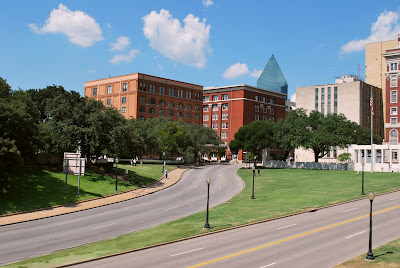Calvary Cemetery - Uptown Dallas
Near Freedman’s Cemetery Memorial there are a few other historical burial sites that the Uptown Dallas Public Improvement District has designated as part of the Uptown Trails Cemetery Tour. The nice thing about these cemeteries is that they include informational signs so that visitors who don’t opt for the Dallas Historical Society’s tour will still have some exposure to the history and famous residents of each graveyard. Today’s post will focus on Calvary Cemetery.
According to a signpost at the entrance, the cemetery was established in 1878 following the land’s purchase by the Bishop of Galveston. This was not the first Catholic cemetery in Dallas, and the oldest dated headstone remaining is for carpenter P.T. Clark, proprietor of the Railroad Planning Mill, who died on April 22, 1877, suggesting that the cemetery was in use prior to the acquisition by the church.
 |
| The style of tombstones in Calvary Cemetery are diverse. |
In the very center is a circle of land ringed with trees that is known as the “Religious Circle” because each person buried was a clergy member of the Catholic Diocese of Dallas, which split from the Diocese of Galveston in 1890 to support North Texas. The first priest ordained in and for the Dallas Diocese was Father Jeffrey Aloysius Hartnett, who is buried within the Religious Circle. A sign post describes the contributions of each of the clergy members, but the story of Fr. Hartnett’s death is of particular note because of his selfless actions.
In 1899 he walked into Dallas’ “pest house” (a smallpox quarantine hospital) to administer last rites. Now known as “Anointing of the Sick,” this is an integral part of Catholic life because it prepares a dying person’s soul for death by providing absolution for sins by penance, sacramental grace and prayers for the relief of suffering through anointing, and the final administration of the Eucharist according to Wikipedia. Fr. Hartnett contracted smallpox during these visits and died a few days later, just as the epidemic began tapering off in Dallas.
 |
| Woodman of the World tombstone at a family plot. |
Calvary Cemetery
2000 N. Hall St., Dallas, TX 75204
Cemetery tours are available through the Dallas Historical Society by calling Nora Lenhart at 214-421-4500 ext. 101 or emailing Nora@dallashistory.org.







Comments
Post a Comment